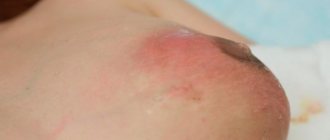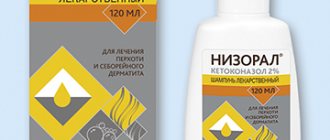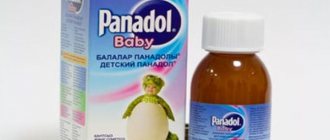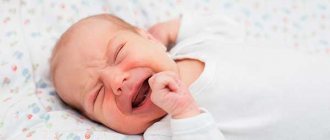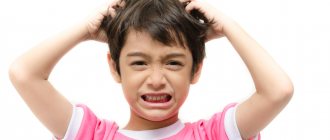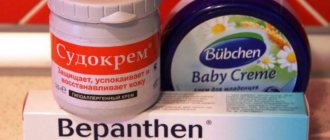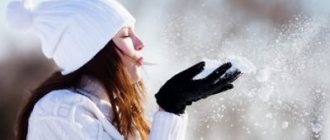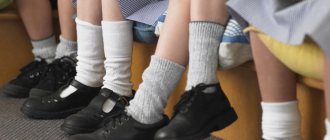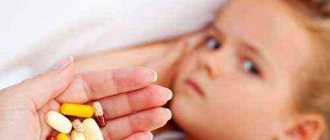Treatment of dandruff in children from birth to adolescence is carried out using specialized medicinal preparations: pastes. shampoos, ointments. To treat dandruff in a child, you can use traditional medicine.
Recommendations from dermatologists and trichologists will tell you how and how to treat dandruff in children of different ages. For each child’s age there is a list of the most effective medicinal drugs and traditional medicine recipes.
Treatment of dandruff in children at different periods of life requires the use of drugs recommended for the child’s age. Getting rid of oily or dry seborrhea and seborrheic dermatitis is not an easy task. The success of its solution directly depends on the timeliness of the measures taken.
Dandruff - what is it?
In the scientific community, this disease is also called seborrhea. What is it? Dandruff is dead skin particles that accumulate on the surface of the scalp. The main cause of the disease is considered to be an imbalance in the production of sebaceous secretions, accompanied by accelerated division of dermal cells. As a result, the damaged particles die and accumulate on the surface, bringing a lot of discomfort to the baby.
In fact, dandruff can occur in a child of any age, but methods for eliminating it in each case must be selected individually.
Doctors distinguish several types of seborrhea in children:
- fat;
- dry;
- mixed.
Features of the course
In newborn babies and children under three years of age, dry dandruff most often appears, characterized by insufficient functioning of the sebaceous glands.
In such a situation, the scalp begins to flake severely due to lack of hydration, which causes the child to experience redness and itching. All these factors negatively affect the condition of the hair, which noticeably weakens and becomes dull.
Oily and mixed dandruff usually occurs in adolescents during puberty. In fact, this process is often normal. Indeed, at this time, a radical restructuring occurs in the child’s body, which entails sharp changes in hormonal levels. Of course, this also affects the activity of the sebaceous glands.
In this case, doctors usually advise using special shampoos that normalize sebum production. This way you can achieve a significant reduction in scalp oiliness.
How to remove dandruff from a baby
Many mothers and fathers, having brought a charming bundle from the maternity hospital and seeing their baby for the first time, may notice that there is some kind of crust on the newborn’s head. For some children, it may appear later - weeks or even months later. This phenomenon is quite common and not at all dangerous. Careful daily care of your baby's scalp will soon bear fruit - the crust will disappear.
The unpleasant appearance of the child and slow hair growth are the two main problems caused by a crust on the head of a newborn. It is usually yellow in color and can be quite dense and thick, but it can also appear in the form of flakes on the skin.
A crust on the head of a newborn is usually located on the top of the head, but can also appear in the frontal part or in the fontanel area. The main thing is to start a timely fight, otherwise the crusts will build up, and their dense layer interferes with the growth of the baby’s delicate hair.
Many parents, wondering how to remove crusts on the baby’s head, begin to actively soap them when bathing the child. Do not overuse this, and especially do not wash your head often with special shampoo. This will only make things worse. The crusts will dry out and begin to resemble sticky translucent dandruff, which is much more difficult to remove, and it can also spread throughout the entire head. Start fighting the crust according to the rules!
First, let's warn young mothers - the crust on a newborn's head should not be scraped off with nails or any other devices! In no case! In wounds and cracks that may remain after
Source
Signs of a problem
The first symptoms of dry dandruff in babies:
- fragility, fragility of hair, appearance of split ends;
- discomfort and itching;
- irritation, dry skin;
- redness of the scalp;
- presence of white grains.
- Oily seborrhea occurs a little differently:
- the child’s hair quickly becomes oily and looks untidy;
- large yellow flakes appear;
- itching;
- wounds and even suppuration are formed.
Keep in mind that any type of seborrhea is accompanied by itching. Parents should react to the problem in time and begin treatment immediately so that the baby does not have time to scratch the scalp. Otherwise, the risk of wounds and their suppuration increases significantly.
Causes of dandruff in children
Seborrhea in a baby can occur under the influence of any factor that leads to excessive division of skin cells. Under normal conditions, renewal of the dermis occurs within a month, and when dandruff appears, this period is reduced several times.
The cells do not have time to completely keratinize before they begin to desquamate. As a result, they simply stick together and form visible scales.
What leads to the formation of dandruff in a child?
- Microscopic fungi. One of the most common causes of dandruff in children is an opportunistic yeast-like fungus. It inhabits the scalp even under normal conditions. But if it multiplies too actively, irritation of the epithelium occurs, as a result of which the surface thickens and seborrhea occurs. But in some cases, dandruff is caused by the activity of pathogenic fungi. They act more aggressively, causing the dermis to become thinner, hair follicles to die, and baldness gradually develops.
- Dysbiosis. Due to disruption of the intestinal microflora, a number of problems develop in the child’s body, for example, the absorption of nutrients and vitamins is disrupted. As a result, the scalp also suffers, which is exposed to pathogenic microorganisms. The toxins produced during their activity affect the dermis, leading to inflammation and the formation of dandruff.
- Immunodeficiency. Immune cells living in the layers of the skin produce protective elements. If their production is insufficient, pathogenic bacteria appear on the skin.
- Excessive sebum production. Teenagers most often encounter this cause of dandruff during puberty; the problem is more pronounced in boys. Due to the influence of male hormones, the sebaceous secretion becomes too thick, blocks the pores and is ideal for the development of bacteria. The result is chronic inflammation, which leads to the formation of dandruff.
Symptoms of dandruff depending on age
From birth to four years
The causes of dandruff on the head of a newborn can be very different. For babies and children up to the age of four, seborrheic dermatitis is more typical, which can go away on its own and appear only in adulthood.
Parents may encounter dandruff in their baby right from the first days after birth. The baby is born in amniotic fluid, which cannot be completely washed off with water. Gradually, the grease turns into yellow scales that are difficult to peel off. Removing them by scraping is strictly prohibited - this can seriously injure the delicate skin of a newborn.
In babies under one year old, the peeling scales become brown, are very itchy and lead to serious discomfort for the baby, who may be capricious, sleep poorly, and lose appetite. When scratching, there is a high risk of infection of open wounds and the development of an inflammatory process.
The cause of dandruff on the head in infants is the residual amount of maternal hormones that activate the production of sebum in the glands. The situation is considered quite common - more than 50% of all newborns experience it.
In a normal course, the process completely disappears on its own two to three months after birth. In some cases, seborrhea can persist for the next two to three years after birth and requires treatment. Before solving the problem, you should definitely consult with your pediatrician.
Dandruff in children 5-7 years old
Dandruff in older ages, starting from five years of age, does not occur due to seborrhea, which is characteristic of newborns. Often the pathological process is “triggered” by incorrectly selected hair care cosmetics. When using overly aggressive shampoos, the protective layer from the epidermis that normalizes the microflora is washed out, which can provoke increased activity of the sebaceous glands. Sometimes it is enough just to change the shampoo for the disease to go away on its own, without any drastic therapeutic measures.
If the pathology does not go away, you should consult a doctor. In some cases, dandruff in a 7-year-old child may be a sign of a disease of internal organs or exposure to external factors, which include sunburn, poorly washed shampoo or conditioner from the hair.
Dandruff in children 8-12 years old
In older children, the causes of seborrhea are similar to those in adults and are associated with the activation of pathogenic microorganisms on the skin. The active activity of the pathogenic environment with the subsequent progression of seborrhea depends on the following reasons:
- lack of microelements, vitamins, minerals in the body;
- disturbance of the microflora of the gastrointestinal tract;
- improper diet;
- metabolic disorders in the body;
- increased secretion production in the sebaceous glands;
- change of climate zone;
- sudden changes in ambient temperature;
- seasonal climate changes;
- decreased functioning of the immune system;
- malfunctions of the nervous system.
To determine the cause of dandruff in a 9-10 year old child, you need to consult a dermatologist. When carrying out the required laboratory tests and tests, the doctor will prescribe treatment with drugs that are sensitive to the pathogenic fungus that caused the disease.
If no conditionally pathogenic fungi were found in the scraping, you may have to consult other highly specialized specialists - an endocrinologist, immunologist, allergist and others.
Less common causes
- Allergy. Against the background of an allergic reaction, immune cells react too strongly to a certain substance, injuring not only it, but also their own tissues. If an allergen comes into contact with the scalp, it becomes inflamed and, accordingly, dandruff is formed.
- Lack of necessary hygiene. Due to insufficient cleansing of the scalp, a film consisting of dirt and fat appears on it, which is perfect for the proliferation of pathogenic microflora.
- Lack of vitamins. Due to a deficiency of nutrients, the full processes of formation of skin cells and their death are disrupted, as a result of which it becomes too dry and very flaky.
- Vegetovascular dystonia. With this disease, disorders affect all organs, in particular the skin. Due to the lack of oxygen and beneficial microelements, it becomes too dry and thin.
The causes of seborrhea are so closely related to each other that it is sometimes simply impossible to separate them. That is why the treatment of dandruff in a child must be comprehensive.
Causes and features of symptom development
It must be said that the appearance of dandruff in a newborn has its own characteristics. The white flakes in the hair of infants, which are common for adults, are almost unusual for infants. Instead, seborrheic crusts may be observed on the child’s head. They may also be present on the eyebrows.
When they are detected, it is very important not to take aggressive mechanical action and not to remove dried areas without special preparation. This behavior can cause injury to the child’s delicate skin and infection in the wound. And since newborns are very sensitive to such interventions, this can cause complications. The only thing that can be done is to provide the scalp with access to air.
Do not over-bundle your baby or put hats on him indoors. It is imperative to prevent the child from accidentally scratching the injured areas. And a baby should be treated for this problem only after consulting a doctor, following all his recommendations.
Before starting treatment, it is very important to establish what causes the formation of dandruff. It is also important to know how this pathology manifests itself at such a tender age, so as not to confuse its symptoms with other diseases.
Typically, dandruff occurs after the proliferation of fungus on the skin. This fungus in most cases does not lead to such pathological phenomena, since it is normally found on the skin of all people, however, in the presence of certain factors that stimulate its development, it begins to actively multiply, which is why dandruff occurs. In an infant, the mechanism of development of this disease is similar.
The situation is complicated by the fact that traumatic factors that contribute to the active proliferation of the fungus act on a baby much faster than on an adult. These factors include the following:
presence of hormonal imbalances;- failure to comply with hygiene rules;
- weak immune defense;
- problems in the gastrointestinal tract;
- vitamin deficiency;
- infectious diseases;
- endocrine disorders;
- unhealthy diet, etc.
Therefore, before starting treatment, it is necessary for the doctor to determine the cause of this problem in the newborn. If it consists of serious deviations of an internal nature, you need to fight them first. External circumstances should also be neutralized, but this task is much easier to cope with, since for this you do not need to choose age-appropriate medications.
To consult a doctor, the child’s parents must suspect the presence of this disease. This is only possible if you know the signs of seborrhea in children of this age. Among them are:
redness of the scalp;- formation of small light-colored scales;
- skin irritation;
- crust formation;
- inflammation, etc.
The manifestation of one of these signs may mean the presence of a completely different disorder in the functioning of the child’s body. But if they all occur at the same time, most likely the diagnosis will be confirmed.
In a newborn baby
In infants, dandruff looks a little different. These are yellowish crusts, which are most often located on the top of the head, in the fontanel area, behind the ears.
If you do not get rid of dandruff in a child in time, the problem will spread further and lead to complications.
There are several reasons for the appearance of seborrhea in infants:
- metabolic disorders in the mother during pregnancy;
- unstable functioning of the sebaceous glands in a newborn;
- care products are not suitable for the child’s skin;
- negative reaction of the body to foods that have just appeared in the mother’s diet;
- deficiency of minerals and vitamins, especially group B;
- harmful microclimate around the child;
- regularly wearing a cap, which interferes with normal air exchange.
A baby's delicate skin is very susceptible to external influences and vulnerable to infectious attacks. The baby’s body reacts sensitively to all sorts of changes around: from the surrounding microclimate to foods introduced for complementary feeding.
Medicinal shampoos
The action of such shampoos is aimed at killing the fungus developing on the head , which provokes the appearance of lumps of dandruff. They also help stabilize the sebaceous glands, preventing the rapid accumulation of fat on the hair, which ultimately spoils the entire appearance and creates the impression of a dirty head.
Using medicated shampoos correctly, you will not only be able to recover from this disease, but also prevent its recurrence.
Today, there are several brands that really effectively cope with seborrhea on the head in children:
- Nizoral.
- Sulsena.
- Friederm.
- Bubchen.
It contains the main component called ketoconazole. This is a very strong shampoo because it kills fungus on the scalp in just 2 days.
The main component of this shampoo is selenium disulfide. Thanks to it, the hair acquires shine, becomes silky, and all signs of the disease (itching, redness) disappear.
It is presented in pharmacies with a whole series of products, each of which is aimed at eliminating a specific problem. So, some cope with oily dandruff, others with dry dandruff. There is a line designed to prevent the appearance of seborrhea and improve the overall health of the scalp.
Also worth mentioning is the Bubchen hair care line. These German products are very popular among consumers.
The course of treatment for seborrhea of the scalp in children using the remedy you like should not be less than 2 weeks . If after this time there is no result, then the shampoo you have chosen should be replaced with another.
Before using medicated shampoo, read the instructions for use.
How to treat seborrhea on a child’s head using shampoos? to use any of the medicated shampoos 2 to 3 times a week . After the white lumps begin to disappear, the frequency of use can be reduced to 1 time every 14 days. The general course of treatment must be extended to 42 days. In this case, you gradually need to return to your regular hair wash.
Find out on our website about other anti-dandruff shampoos: for men, women, for oily and dry dandruff, about “Horsepower”, “Head-and-Shoulders”, “Clear Vita Abe”, “Alerana”, “Vichy” shampoos, “Sebozol”, “Fitoval”, “Kitonozol”, tar shampoo, with zinc, and also how to make the products yourself.
In children from one to ten years of age
Here are some of the most common reasons:
- illiterate care, unsuitable soap, shampoo and other products;
- poor nutrition, which leads to disruptions in the digestive tract;
- in children 7-9 years old, seborrhea often occurs due to skin pathologies, for example, psoriasis and dermatitis;
- in a 3-year-old child, dandruff may appear after helminthic infestation or pediculosis;
- allergic reaction to medications, products, care products;
- nervous disorders, tension, stress when entering school or kindergarten;
- deviations in the functioning of the nervous, digestive, endocrine systems.
Keep in mind that dandruff in a child can occur after contact with a sick person, for example through personal hygiene items, a comb, a cap and other objects. Fungal diseases do not go away on their own.
Causes of the problem
The reasons for the appearance of dandruff in a child are very diverse, and if the disease cannot be eliminated for a long time, parents should think about it and visit a doctor, who will assess the situation and refer for additional research. Among the factors that provoke diseases, the most common are:
- Improper care of the scalp. The secretion of the sebaceous glands has not yet been established in an infant, and if the parent buys unsuitable detergents, there is a high probability of dandruff formation.
- Allergic reaction. If a baby has peeling on the head, which is accompanied by redness and itching of the skin, it may well be that the body is reacting to the allergen in this way. If the baby is breastfed, the mother needs to reconsider her diet and remove possible allergenic foods.
- Parasites. Dandruff can appear due to helminthic infestation or lice infection. Because of this problem, severe dandruff can be detected in a child aged 5 years.
- Stress. Baby dandruff caused by stress is common. If the child is nervous or under constant tension, the disease may appear at 2 years of age. Often the trigger is considered to be stress due to a change in environment when the child comes to kindergarten for the first time.
- Endocrine disorders. They most often appear in adolescence, when hormonal levels change in boys and girls and the functioning of the sebaceous glands is disrupted. Dandruff in teenagers during this period is common.
Other causes of dandruff in a child
Dandruff is flaking on the scalp.
In addition to the above reasons, there are other factors that influence the appearance of dandruff in a child:
- Poor nutrition. If a child's diet is not balanced, many health problems appear, and severe dandruff in this case is one of the first to occur. It is worth enriching your child’s menu with products containing sufficient amounts of vitamins C, D, and B.
- Bad habits. Often a 15-17 year old teenager wants to try alcohol and other bad habits. This can also provoke a violation of the secretion of the glands and cause the formation of dandruff, which will then be difficult to get rid of.
- Skin pathologies such as eczema, seborrhea, psoriasis. More common in children in adolescence.
- Problems with the functioning of the digestive system. There is no point in fighting dandruff if you do not get rid of digestive problems. Problems with the functioning of the gastrointestinal tract most often affect older children aged 10 years and older.
Your child has dandruff: what to do?
How to wash your baby’s hair to get rid of seborrhea, and what other products can be used for therapy? It is best to consult a dermatologist with these questions. Hair loss, severe itching and flaking of the skin are signs that it is best for your child to go straight to the doctor.
The dermatologist will carefully examine the little patient, collect the necessary medical history and give a referral for tests. The main thing is to identify the cause of dandruff in a child; treatment largely depends on this. The therapy itself must be comprehensive. Tactics are selected depending on the age of the baby.
About crusts on the head of newborns - causes and how to remove them
Parents are usually concerned when a kind of crust appears on their child’s head. The mother may notice such a small growth even in the maternity hospital. In some children, these crusts persist for up to a year, and although they do not cause any inconvenience to the children themselves, parents still strive to get rid of dubious growths. That is why all mothers should arm themselves with information about what crusts on babies’ heads are, whether they are harmful and how to remove them.
Despite the fact that the formation of crusts is a natural process, some parental actions can increase their growth:
Overheating. Babies who are bundled up even when warm and wearing a hat sweat more. This causes crusts to form more actively.
Frequent hair washing. The baby's skin does not yet have reliable protection, so frequent washing of the hair with shampoo or soap only aggravates the situation.
Using inappropriate household chemicals. Shampoos and washing gels, with
Source
Therapy for children under one year old
How to remove dandruff from a child at this age? This is not difficult to do.
- After bathing, apply baby oil to your baby's head and apply it gently. Then put on a cotton cap to make the crusts softer.
- Using a soft brush, carefully comb out the flakes.
- Then wash your baby's hair again using shampoo to remove any remaining oil.
This procedure must be carried out twice a week. If the crusts are too hard, you can leave the oil overnight.
Does a child under one year old have dandruff or seborrhea?
The crusts mentioned above are called seborrheic. This is how seborrheic dermatitis manifests itself. It is popularly called " milk cap " or " lullaby cap ". In fact, crusts are a severe form of dandruff in newborns up to one year old.
For reference : seborrhea of newborns usually occurs on the top of the head, but it can appear on the sides, in the fontanel area and even behind the ears. In more severe cases, crusts can spread to the ears, face, armpits and groin area, which is already called seborrheic eczema.
Crusts on a baby’s head
are almost impossible to remove with plain water .
If no action is taken, they dry out, covering each other and forming a translucent crust very similar to dandruff.
When combing a baby's hair, dandruff is separated from the surface of the head and sticks to the hairs. This makes the head look untidy.
Important : with seborrheic dermatitis, unlike other forms of this phenomenon, there is no need for drug treatment.
Doctors' recommendations
If a child’s dandruff is associated with the mother’s diet, the diet should be reconsidered. The first thing you need to do is eliminate salty and fatty foods, as well as sweets. And the menu should be replenished with foods high in vitamin A.
Often the cause of seborrhea in infants is the wrong shampoo. So choose the product especially carefully. Shampoo for a baby should be of high quality, and it should not contain dyes or any additives that dry out the skin.
In addition, there is no need to wrap the baby tightly. Excessive sweating often leads to dandruff.
Prevention measures
Prevention of dandruff in infants
To prevent dandruff and crusts from appearing on a newborn’s head in the future, you need to:
- Carry out hygiene procedures in a timely manner and in the required volume, use natural-based baby shampoos.
- Periodically give your baby a scalp massage using nourishing vegetable oils.
- Observe the thermal regime in the room, do not wrap the child up and allow the scalp to breathe more often.
- Give your child more attention and avoid stress.
How to treat preschool children
In addition to correcting the diet, these babies require the use of medicated shampoos and certain medications. True, their selection should be carried out by a dermatologist.
How to get rid of dandruff in children of preschool and primary school age? Treatment involves several stages.
- Use of antihistamines. Such products eliminate itching, so skin irritation disappears.
- Using a special shampoo. It should have an antifungal effect. Don't forget to find out at what age you can use this shampoo.
- Use of sprays. If a child has severe dandruff, this remedy will certainly help him.
- Alternative methods. All kinds of decoctions have a positive effect on the condition of the skin, providing antimicrobial and anti-inflammatory effects.
Treatment of dandruff (seborrhea) in adolescents
As already mentioned, seborrhea and seborrheic dermatitis develop in adolescents due to hormonal changes. At this age, the following drugs are recommended for the treatment of dandruff:
- "Dermazol";
- "Dandruff";
- "Sebozol";
- "Sulsena Paste";
- "Nizoral";
- "Zinc perithion";
- "Friderm tar."
All of the listed medications have analogues, so it is not difficult to find a drug that will be affordable. When choosing, you need to pay attention to the composition. It should contain components such as ketoconazole, zinc perithione, selenium sulfide, sulfur, panthenol.
It is recommended to use medicated shampoos and pastes no more than 3 times a week. You should always pay attention to the instructions for use given by the manufacturer of the drug. Most often, the treatment process with shampoos is two-phase.
- First, wash your head with a medicinal product.
- Apply a small amount of shampoo to clean, damp hair and skin and leave for 5-7 minutes. After this, the head is washed well with running water.
Treatment of older children
Getting rid of dandruff in a child over 8 years old is much easier. After all, at this age children can already be given various medications, and the baby himself already knows that he should not be capricious and disturb his parents.
The main thing is to know how to eliminate dandruff in a child.
What to do? Follow several stages of treatment.
- Taking antihistamines.
- Using shampoo containing ketoconazole. This product effectively fights fungus and eliminates itching. If we are talking about an advanced form of seborrhea, you can supplement the treatment with tablets with the same active substance.
- Application of castor oil. Heat it in a water bath and gently apply to the scalp. After 2 hours, the oil can be washed off.
- Tar. Eliminates inflammation and suppresses fungus. Tar should be added to shampoo or used in the form of soap.
- "Sulsena". Effectively suppresses fungus and eliminates severe itching.
- Tea tree oil. It must be added to shampoo.
- Lotion "Bifon". It should be applied to the skin without rinsing off. The product stabilizes the activity of the sebaceous glands and destroys fungus.
Dandruff in children Komarovsky
Dandruff in children
Dandruff is a mild form of dermatitis.
The scalp itches and the flakes of dead skin cells are so large that they are easy to notice. Dead skin cells and dandruff accumulate due to infrequent and careless hair washing. Dirt, dirt and sebum residues in the child's hair and scalp stick together skin cells, which fall off in the form of flakes onto the shoulders.
Dandruff is more of a cosmetic problem than a medical one. Often, dandruff appears due to poor nutrition.
Traditional treatment is anti-dandruff shampoos or antifungal agents.
BASIC ACTIONS FOR DANDRUFF
Nutrition
Often the main cause of dandruff is a lack of saturated fatty acids. Give your child more foods that are high in saturated fatty acids, such as fish, seeds, nuts and sprouted flaxseeds. Breastfeeding mothers should consume more saturated fatty acids to pass them on to their babies.
Eat healthy and whole foods. Sensitivity to certain foods may be important. Yogurt with live cultures increases the number of beneficial bacteria that kill fungi that cause dandruff.
Nutritional supplements
Give flaxseed oil or fish oil, or better yet, a mixture of saturated fatty acids for children. It should be high in omega-3 and omega-6 fatty acids (especially gamma-linolenic acid or GLA). If you are using flaxseed oil, give 1 teaspoon per day to children under 2 years of age, 2 teaspoons to children 3 to 6 years of age, and 2 to 3 teaspoons to children 7 years of age and older (start with 1 teaspoon per day and decrease dose if diarrhea occurs). If using fish oil, give 1 gram per 22.5 kg of body weight per day.
Herbal medicines
Tea tree - use shampoo with 2-3% tea tree oil to wash your child's hair.
Olive oil - rub into scalp at night. It moisturizes the scalp and also contains essential saturated fatty acids.
Homeopathy
Choose a medicine that suits your child's symptoms. Unless otherwise indicated, the usual dosage is two tablets of ZOS dilution 2 times a day.
Improvement should occur within 7-10 days. If there is no improvement within 10 days, try another remedy. Stop giving the medicine once you notice improvements. Resume use only if symptoms begin to return.
Note: low dilution products (6X, 12X, 6C) should be given more often (three times a day).
Graphites - for scales with yellow liquid and severe itching. It helps well against dandruff, mainly located on the back of the head.
Potassium sulfate - especially good for yellow scales.
Table salt is especially good for white flakes. The child prefers salty foods and likes to be left alone.
Sulfur - for dry dandruff with itching and burning. As a rule, the child constantly has a slightly elevated temperature, is hot to the touch, and the skin is susceptible to diseases. The child drinks a lot of cold drinks.
ADVANCED ACTIONS
Nutritional supplements
Complex B—Give 25 milligrams per day to children under 7 years of age or 50 milligrams per day to children 7 years of age and older. Exists in liquid form.
Children's multivitamins - provide the necessary complex of vitamins and minerals. Give daily. Available in liquid and chewable forms.
Aromatherapy
Add chamomile and tea tree oil to aloe vera gel or olive oil and massage the mixture into your scalp every night. Do not use aromatherapy if your child is taking homeopathic remedies.
Dandruff on a child’s head – dealing with the problem
Surprisingly, dandruff can occur in both infants and teenagers. Scalp cells tend to renew themselves every month, but if metabolic processes in the body are disrupted, this leads to an imbalance in the interaction of internal components and leads to the formation of dandruff. Dandruff in a child is the result of a failure of metabolic or hormonal processes. With these changes, the oval pityrosporum fungus, which lives on everyone’s head, begins to actively function and provoke the appearance of even more white scales.
Causes of dandruff in children
- Hormonal disorders during the period of activation of the gonads
- malfunction of the adrenal glands and thyroid gland
- nervous diseases and vascular diseases of the head - vegetative-vascular dystonia
- Immune system disorders and past illnesses
- staphylococcal and streptococcal infections
- avitaminosis
- unhealthy diet with an excess of carbohydrate foods with an abundance of sugar
- manifestation of an allergy to one or another cosmetic hair product
- a banal infection from another peer when using someone else’s comb, wearing a headdress, or hairpin.
- Massage your head with a comb before washing. The massage brush can be pre-lubricated with herbal healing oil of tea tree, rosemary, burdock or eucalyptus. You can perform a massage based on a decoction of medicinal herbs: burdock, nettle, horsetail, coltsfoot
- wash your hair with sulsen paste or soap
- rinse your hair with a decoction of the peel of four lemons per liter of water, or a decoction of yarrow herb
- carry out ultraviolet treatment. Allow your child to be in the sun without a hat for 15-20 minutes a day.
Dandruff in a teenager is one of the manifestations of changes in the child’s body.
Hormonal maturation is a complex process in which all body systems are involved. A teenager's hair is characterized by increased fat content, and for the appearance of dandruff it is a real paradise. Everyone has dead flakes of hair on their head, but if these flakes are visible on their hair and clothes, then this is a reason to think about the presence of a disease. This manifestation of scalp disease is called oily seborrhea.
Dandruff in children can also appear on dry hair - dry seborrhea. In this case, it will look like white-gray flour. This type of dandruff is very abundant; children’s clothes, especially in the shoulder area, will be completely covered with dead scales.
Children are very vulnerable, any discomfort in the external image brings them enormous psychological trauma, giving rise to a complex; the situation with dandruff needs to be corrected immediately, because seborrhea provokes hair loss in the child.
Treatment of dandruff in children
A lot of information has been written about how to cure dandruff in a child.
Treatment of dandruff in children should be carried out both with nutrition - a competent diet, and external hair treatment - selection of shampoos, antifungal ointments, masks.
Child nutrition. for those suffering from dandruff, it should be well-balanced and rich in vitamins. Children with oily hair should avoid all sweets and starchy foods, chocolate and carbonated drinks. The child’s diet should not contain products made from butter or yeast dough; for some time it is better to limit himself to rye bread with bran, crispbread, and sprouted wheat sprouts. The diet should primarily consist of fiber-rich dietary fiber. It should be vegetables, herbs, fruits, dried fruits, nuts, and legumes. Protein foods should not be fatty, you should eat more seafood. We should not forget about dairy products and vegetable oils, which contain pumpkin and sunflower seeds, coconut, walnuts, and pistachios.
External means of getting rid of dandruff are medicated shampoos, which must necessarily include components that can resist fungus, such as: ketoconazole, octopirox, selenium sulfide, pyrithioneate, sulfur, salicylic acid, tar.
The components of a medicated anti-dandruff shampoo for a child should treat, have an antimicrobial effect, heal microcracks, have an exfoliating and anti-inflammatory effect, resist sebum secretion, and care for the hair structure. Experts recommend the following medicinal shampoos: “Nizoral”, “Friderm-tar”, “Friderm zinc”.
Before purchasing this or that medicinal product for a child, it would be a good idea to consult with a specialist - a trichologist or therapist.
Among the folk recipes for the treatment of dandruff in children, it is recommended
Dandruff in a child: where, why and how to get rid of it?
Content
Dandruff is not just a cosmetic problem. Often the reason lies in the disruption of organs and systems. It is especially unpleasant if this problem occurs in a child. It causes itching and discomfort. Where is the cause of dandruff hidden and what to do if it appears in a child?
Causes of dandruff in children and adolescents
Most often, the cause of dandruff is considered to be an incorrectly selected hygiene product. And they begin to alternate shampoos one by one, further aggravating the situation. Sometimes the cause of excessive flaking of the scalp can be an allergy to the hair wash, but this has nothing to do with seborrhea and goes away quite quickly after taking antihistamines.
Main reasons:
- Poor nutrition. Dandruff can be a consequence of eating large amounts of sugar, flour and fatty foods.
- Disturbances of the endocrine system.
- Weakened immunity, insufficient intake of vitamins and minerals into the body.
- Hormonal changes. This reason is relevant for children over 10 years old.
- Heredity. Often the tendency to develop seborrhea is hereditary, and dandruff can appear even in children as young as 2 years old.
- Diseases of internal organs, infections.
- A fungus caused by non-compliance with personal hygiene rules, the use and wearing of other people's things.
As you can see, there are quite a lot of reasons for the appearance of dandruff and it is not always possible to find out the real one, especially if it is not possible to contact a specialist. In this case, treatment should consist of following a proper diet and using external dandruff remedies.
Diet for treating dandruff
The therapeutic diet for seborrhea in children from 2 to 10 years old consists of limiting the consumption of foods that provoke the secretion of excess sebum and disruption of metabolic processes in the body.
When treating dandruff in a child, you need to exclude from the menu:
- Sweet dishes, limit sugar consumption to 15 grams. in a day.
- Chocolate, confectionery.
- Carbonated drinks, packaged juices.
- Sausages, semi-finished products.
- Fatty and fried foods.
- Products filled with artificial colors and flavors.
The menu must include:
- Seeds, nuts.
- Vegetables, fruits, greens.
- Lean meat, fish, seafood.
- Dairy products.
- Cereal porridge
- Bread made from wholemeal flour and cereals.
In addition to diet, a child under 10 years of age must be given complex multivitamins or at least B vitamins. Fish oil will be of great benefit in treatment.
How to get rid of dandruff in a 2 year old child
Not all medications can be used on a child aged 2 years, so before starting treatment, you need to carefully read the instructions. The child must be given antihistamines throughout the entire treatment period. They will help get rid of itching and relieve skin irritation. At the age of 2 years you can take Zodac (Zyrtec), Fenistil drops. Fenistil is also prescribed to newborns.
Treatment of dandruff in children aged 2 years:
- Shampoo Friederm zinc. It has no contraindications based on age and can be used in children even under 2 years of age. Has antimicrobial and antifungal effects. Relieves problems caused by various reasons, including allergies. Has a positive effect on the scalp and hair.
- Decoctions of string and yarrow. These herbs have a positive effect on the condition of the scalp and have a bactericidal and anti-inflammatory effect. You can give baths and lotions to children under 2 years of age and even newborns.
- Skin cap. Available in the form of spray, cream and shampoo. Effectively copes with oily and dry dandruff. It has no contraindications, except for individual intolerance. Not sold in all pharmacies, but you can order it.
When treating children 2 years of age, precautions must be taken to ensure that the products do not get into the mouth or eyes. If the child is capricious, then you can additionally give sedatives, for example, valerian.
How to get rid of dandruff in a child under 8 years old
It is easier to treat an 8 year old child than a 2 year old one. There are more medications and means, the treatment process is easier. The child already understands everything and is not capricious. It is also recommended to give antihistamines. At 8 years old Suprastin is suitable.
Anti-dandruff remedies for treating a child 8 years old:
- Products containing Ketoconazole. There are a lot of them, for example, the famous Nizoral shampoos and creams. Ketoconazole effectively combats fungi that cause dandruff and itchy scalp. In advanced and complex cases, tablets with this active substance may even be prescribed.
- Tar. Has anti-inflammatory and antifungal effects. This remedy is also effective in healing the scalp and can be used in children as young as 8 years old. You can use both natural pharmaceutical tar, adding it to various folk remedies, and tar soap or shampoo.
- Castor and burdock oil. The oils are mixed in equal proportions, heated in a water bath and rubbed into the scalp. Keep for 2 hours. You can add vitamin A in oil or Aevit.
Also, at the age of 8 years, you can already use folk remedies. For example, rub aloe juice or a decoction of walnut leaves into the scalp. Rinsing your hair with water with lemon juice, a decoction of nettle or calendula flowers helps get rid of dandruff.
How to rid a 10 year old child of dandruff
At the age of 10, children may already begin to experience hormonal changes, and the appearance of dandruff may be caused by this reason. Therefore, before starting treatment in adolescents, it is advisable to consult a doctor. If dandruff is caused by a riot of hormones, then the child’s skin on the face will increase in oiliness, and rashes may appear.
Anti-dandruff remedies for treating a 10 year old child:
- Sulsena. An effective antifungal agent that relieves itching after the first use. Positively affects the scalp and hair. Available in the form of cream, soap or shampoo.
- Tea tree oil. An effective dandruff remedy. A few drops are added to the shampoo immediately before washing. It will help get rid of it if you do it every time you wash your hair.
- Bifon lotion. Can be used in children 10 years of age and adolescents. Destroys fungus, normalizes the functioning of the sebaceous glands on the head, reduces itching. Apply to clean scalp and do not require rinsing.
- Gargling with lemon peel decoction also helps get rid of dandruff.
- For oily dandruff and scalp, rubbing with calendula tincture will help. The product is applied to the skin, massaged and left for half an hour, then the head is washed as usual, using shampoo.
For dandruff in teenagers, you can use products intended for adults. As a rule, over the age of 10 years, dandruff is oily, hair quickly becomes greasy and looks unsightly. Therefore, in addition to using products to treat dandruff, you need to choose shampoos wisely. They should cleanse your hair well and remove excess oil.
If after long-term treatment there is no improvement, then it is advisable to visit a trichologist (if there is no dermatologist) and undergo an examination. Perhaps the cause of dandruff in a child is insignificant and can be easily eliminated without the use of numerous medications and folk remedies. And always remember, if a child plays sports, then this problem is less common, or at least you need to do exercises in the morning.
loading.
Article rating:
(voted: 2. rating: 4.50 out of 5)
Dandruff in children
White flakes. that fall from your child's head to his shoulders - dandruff in children. This is a syndrome that is characterized by scaly detachments and severe itching for a long time. Dandruff is more common in children than in adults.
Causes of dandruff in children
There are many reasons for the appearance of seborrhea. but the main ones are disorders of the endocrine and nervous systems, metabolic disorders and other metabolic processes in the gastrointestinal tract. But why does dandruff occur in children at such an early age? The thing is that your child’s body is not formed, and therefore is exposed to various internal and external negative factors. An infant may even have dandruff. This is explained by another very important factor: hereditary predisposition. Perhaps the child has structural features of the skin and its secretion.
The nature and process of dandruff in children
Dandruff is caused by the fungus Malassezia globosa. This fungus is not able to produce its own fatty acids. It uses external sources of these substances. Such sources are the secretions of the human sebaceous glands. That is why he is so attracted to places characterized by increased activity of the sebaceous glands. In the process, there is a possible change in the chemical composition of sebum. Its quantity and quality depend on the condition of the body, age and gender, diseases that affect it. That is why it is worth thinking about the health of the nervous, endocrine systems, as well as the digestive tract. The greatest amount of fat is released during adolescence. that is, during puberty. Eating large amounts of fatty, sweet and spicy foods, hypovitaminosis, chronic infections, skin pollution - all this aggravates the course of the disease. If you notice dandruff in children, you should think about a comprehensive diagnosis.
Even more damage to the scalp occurs due to scratching caused by itching. In this case, it is worth thinking about the allergic nature of the origin of seborrhea. Very often, dandruff in children occurs due to poor diet. Dysbacteriosis may be accompanied by detachment of epidermal scales. Sometimes dandruff in children is attributed to fungal diseases, moreover, contagious.
To some extent, experts are right, since dandruff in children can be transmitted through combs. hats, towel. Scratching alone is not enough to become infected with dandruff. Dandruff in children is accompanied by a number of contributing conditions. Firstly, it is reduced immunity. Secondly, lack of B vitamins. Thirdly, emotional and mental stress, fatigue, poor nutrition, chronic or acute processes in the gastrointestinal tract.
Therapy against dandruff in children
Dandruff in children can occur after using the wrong soap or shampoo. Remember that zinc-based shampoos dry out the scalp. They are suitable only for oily dandruff in children. If your child has dry scalp, you should never use it! Not all hygiene products are suitable for your baby. For example, products that strongly cleanse the scalp, and also those that lead to a decrease in the acidic and oxygen properties of the skin. If the cause of dandruff in children is difficult to establish, general principles of therapy can be used. Firstly, this is the normalization of metabolism, the use of methods such as for yeast infections. Secondly, a balanced diet, a normal daily routine. Thirdly, use low-alkaline detergents. If necessary, use medicinal shampoos, such as with tar, azoles (bifonazole, ketoconazole), with chalcogenide compounds, shampoos with zinc pyrithioneate. Remember when treating dandruff in children. dandruff in an infant, you need to be especially careful!
If dandruff in children occurs due to stress. we need to fight this psychological state. For example, take a course of sedatives and dandruff in children will stop bothering you. The main thing is not to be depressed in the future. A very large number of exfoliating keratinized particles may indicate hormonal changes.
During puberty, disruptions in the functioning of the endocrine system are very common. Dermatologists recommend heavily consuming plant-based foods high in microelements and vitamins. Grapes, bananas, lemons, tomatoes, parsley, carrots, onions, etc. are perfect.
Rinsing with decoctions of herbs and chamomile flowers will help overcome dandruff in children. What could be better than natural ingredients?
When choosing a shampoo, remember that you should always consider your scalp type, as such shampoos can have the opposite effect.
The most interesting news
Sources: www.mama.biz.ua, vypadvolos.ru, headhairs.ru, nmedicine.net
Next articles:
Alternative medicine
You can treat children who are not suitable for pharmaceutical products using folk recipes.
- Masks. If a child is diagnosed with oily seborrhea, you can use a mixture of ground cherries, currants, St. John's wort and nettle. The prepared product should be applied to the head and washed off after half an hour. A treatment session can be performed no more than once every three days.
- Decoctions. They must be used after washing your hair as a rinse. As a basis for preparing decoctions, you can take onion peels, chamomile, yarrow and lavender.
- Tinctures. From the same plants you can prepare infusions that can be used to treat children of any age.
- Oils. Flaxseed, sesame, cedar, and burdock oils must be rubbed into the skin several hours before the scheduled shampooing.
Treatment of pathology
Systemic
Systemic treatment aimed at eliminating the root cause of the pathology will help rid the child of such a problem; it consists of observing:
- Proper, balanced nutrition, which contains all useful products of plant and animal origin in quantities sufficient for a certain age.
- A regime of wakefulness and rest, which will help calm the child’s nervous system and quickly cure the disease.
- Regimen for taking auxiliary homeopathic medicines that will help get rid of digestive problems and increase the body's resistance to external irritants.
Local therapy
If a boy or girl has severe dandruff, you should take a responsible approach to choosing hygiene products. It is important to use hypoallergenic soap and shampoo, and if the doctor has prescribed a special drug, then it should be used according to the proposed scheme. You can wash your hair with shampoos that are sold in pharmacies:
- "Nizoral";
- "Sulsena";
- "Friderm";
- Bubchen;
- Mustela.
Dandruff in a child goes away after a month of regular use. During the week, wash your hair 2-3 times, but if your head itches badly, medicated shampoos, in consultation with your doctor, are used more often. Despite the effectiveness and safety of anti-dandruff detergents, you should not buy and use them yourself, especially when it comes to treating a scalp disease in a small child.
Folk remedies
There are many folk remedies that need to be taken along with the medicine.
Folk remedies in combination with pharmaceutical special preparations will help cure the scalp and remove unpleasant white flakes. Vegetable oils have proven themselves well, they are hypoallergenic and are perfect for treating the problem even for small children. The most commonly used oils are:
- almond;
- linen;
- sesame;
- cedar;
- burdock;
- castor;
- grape seed and walnut oil.
It is simple to use, 2-3 hours before hygiene procedures, lubricate the scalp with any of the selected oils, then wash your hair with a pharmaceutical preparation. Within a month, the condition of the scalp will noticeably improve, peeling and irritation will disappear, and in case of oily seborrhea, pustular rashes will disappear.
You can rinse your hair with infusion of chamomile, string and nettle. To prepare the rinse aid, take the proposed raw materials in equal proportions, pour boiling water over it and let it brew for 25-35 minutes. After each shampoo, use the infusion as a rinse. Every time before washing your hair you need to make a fresh infusion.
